Onyeka Ndukwe
This blog post provides guidance for developing policy, processes and tools to support the full and effective implementation of competency-based management across the complete talent management lifecycle, including: Recruitment and Selection, Learning and Development, Performance Management, Career Development and Succession Management, and Strategic Human Resource Planning.
Click to view this report as a PDF
(no sign-in required, right-click + save as to download)
Why Competency-Based Management?
Competencies are observable abilities, skills, knowledge, motivations or traits defined in terms of the behaviors needed for successful job performance.
While competencies are not new to most organizations, what is new is their increased application across varied human resource functions. HR professionals are looking for new ways to acquire, manage and retain the precious talent needed to achieve their business goals, and are using competencies to do it.
Properly designed, competencies translate the strategic vision and goals for your organization into behaviors employees must display for your organization to be successful. Competency-based management standardizes and integrates all HR activities based on competencies that support organizational goals.
This comprehensive blog post will teach you about key factors that need to be taken into account to make sure that the competencies will support all the intended applications in the long term, and overarching considerations to ensure alignment of the talent management lifecycle and strategic organizational goals
In a hurry? Jump straight to your section of interest by clicking on a link (see below).
Article table of contents (jump to a section):
1. Getting Started with Competency Implementation
a. Sample Competency Profile
b. Competency Architecture
c. The Competency Layers within A Competency Architecture
d. General Competency Sample
2. Implementing Competencies for Recruitment and Selection
3. Implementing Competencies for Learning and Development
4. Implementing Competencies for Performance Management and Multi-Source Feedback
5. Implementing Competencies for Career Development and Succession Management
6. Implementing Competencies for Strategic Human Resources Planning
7. Overarching Policy, Process and Tools
8. How HRSG Can Help With Your Competency Implementation
Getting Started with Competency Implementation
The starting point for any competency initiative is a valid competency profile that supports all intended HR goals.
What is a Competency Profile?
A competency profile is a selection of competencies with specified proficiency levels required for successful performance in a particular job.
Sample Competency Profile (Figure 1)
Below is the image of a sample competency profile by HRSG:
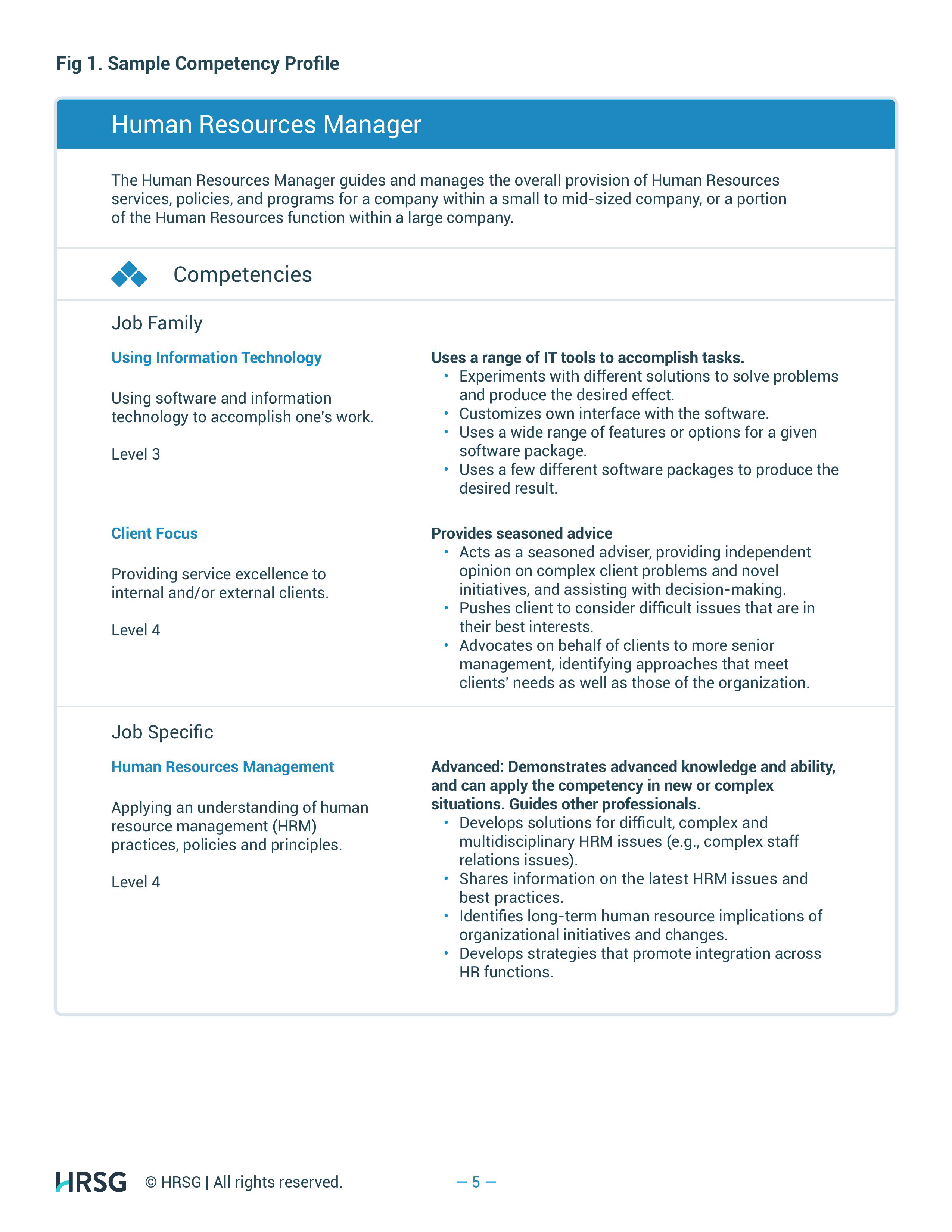
Competency Architecture
Establishing a clear competency structure is one of the first and fundamental steps in profile development. This structure is referred to as a Competency Architecture.
A competency architecture describes the common rules that guide the development of competency profiles. It describes how the profiles will be designed for your entire organization, including the format for displaying the competency profile and the content for the profile.
There are three basic criteria that competency structures must meet:
- The competency profile includes the competencies that employees must have, both now and in the future, to ensure your organization can achieve its vision and support its values;
- The competency profiles must support all of the intended HR applications; and
- All competency profiles must be easy to use by all stakeholders.
Several competency architectures are possible, and you will need to identify the architecture that best meets your needs. Figure 1 represents a model that is commonly used. This, or similar models, have been used successfully by many organizations as the basic framework for developing competency profiles.
The Competency Layers within A Competency Architecture
The competency profile depicted in Figure 1 builds from the vision, values and strategic business priorities of the organization and includes the following competency layers:
Core Competencies are shared by every employee in the organization—from the CEO to the part-time temporary worker. Core competencies describe, in behavioral terms, the key values and strengths that help an organization achieve a competitive advantage by differentiating itself from its competitors. Core competencies are typically general competencies—competencies describing the general behaviors required to perform effectively in a range of jobs.
Job family competencies are shared by a ‘family’ of related jobs that have common functions and form a logical career path. A job family may define a specific department or organizational unit, but it may also define jobs across departments or units that share common tasks and functions. (For example, salespeople selling different products in different divisions may belong to the same job family.) They often include general competencies that tend to be required in a number of job families, as well as technical competencies—competencies describing the application of knowledge and skills needed to perform effectively in a specific role or group of jobs.
Job specific competencies define the skills needed to perform effectively in a specific role or subset of roles beyond those included in the job family competencies. They tend to be technical competencies that specify the skills and knowledge needed to perform effectively.
Leadership competencies (not depicted in Figure 1) are used to define roles in an organization that involve managing, supervising or influencing the work of others in some way. Depending on the organizational structure or culture, leadership competencies may be reserved for a specific leadership team, or applied more broadly to all employees. Leadership competencies can be treated either as an additional layers on a profile, or as a specific job family.
Consistent with the requirement for ease of use, organizations typically define a limit on the number of competencies that are included in the profile for any job within the organization. As a rule of thumb, best practice organizations establish a limit on the total number of competencies included in any one profile in the range of 10 to 12.
Proficiency Levels
To get the most of out of a competency-based approach, we recommend using multi-level competencies that allow you to articulate a particular competency at multiple, progressive levels of proficiency. A proficiency scale reflects the breadth of proficiency typically required by the organization within a competency area.
For example, communication skills may be a requirement for most entry-level jobs as well as at the executive levels; however, the depth and breadth of communication proficiency needed at these two levels may be quite different.
The proficiency scale serve two purposes:
- It facilitates planning and development for improvement within current jobs; and
- It allows for comparisons to occur across jobs, roles and levels, not only in terms of the competencies required, but also the proficiency levels needed using a common incremental scale.
Thus, having competency proficiency scales supports career development, succession management and human resource planning activities within the organization.
General competencies are most often expressed as incremental competency proficiency scales— in other words, proficiency at one level assumes proficiency at all levels below that level on the scale. Technical competencies, on the other hand, may be expressed as common group requirements and, where required, differences in proficiency requirements may be noted.
An example of proficiency levels within a competency is shown in Figure 2 (see below).
Target Proficiency Levels
Organizations typically define in their competency profiles the levels of proficiency to be attained for each competency. These are often driven by the intended use of the competency profiles. For example:
- Entry is the standard expected of employees on entry into a role. This is often used when the new entrant must learn to be able to perform to the standards required within the job.
- Fully Effective is the level required of employees who are performing at the standard expected for their role.
- Stretch/Mastery is typically displayed by employees who have mastered their job. These employees are often sought out by others to provide advice and assistance.
It is important to define what standard of performance will be modeled in the competency profiles as a component of the competency architecture. An example of how these standards for employee performance relate to competency proficiency is shown in Figure 2 (see below).
General Competency Sample (Figure 2)
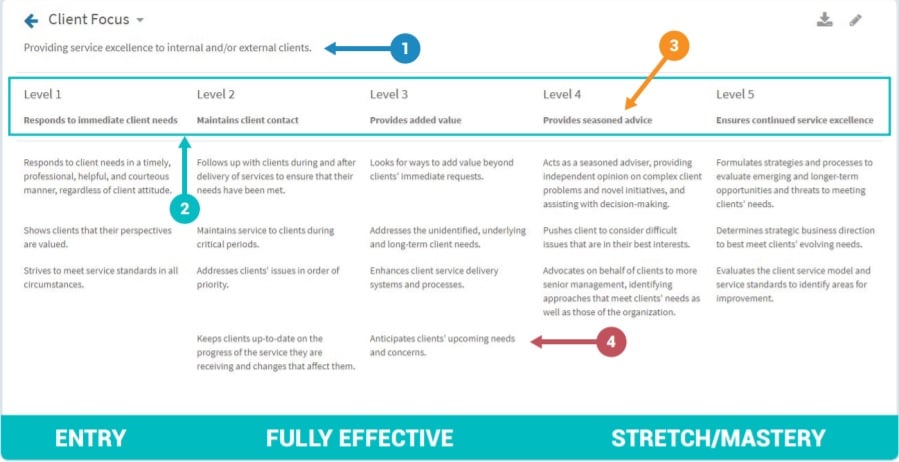
- The competency definition provides a high-level description of the competency.
- The proficiency scale provides multiple proficiency levels for each competency. Each level reflects a progression from a basic demonstration of the competency towards a more complex and strategic demonstration.
- For example, an entry-level employee may need to demonstrate level 1 proficiency, while an executive may need to demonstrate level 4 or 5. Proficiency scales help you compare requirements across jobs, which is especially useful when determining potential career paths within the organization.
- The notion for each level provides a high-level summary of the overall theme identified for that proficiency level.
- A behavioral indicator provides a clear description of the observable behaviors that an employee will demonstrate on the job.
What Is a Competency Dictionary?
A competency dictionary includes all of the competencies needed to cover all of the jobs in your organization.
Building Your Own Versus Purchasing a Dictionary
You may chose to create your own competency dictionary, or purchase one that has been developed by experts in competency development.
The advantage of developing your own dictionary is that it will reflect the breadth of competencies that are required for success expressed in a way that reflects the values, vision and way of communicating within your organization. But this option is very costly and time-consuming, and most organizations do not have the internal expertise to embark on such a venture.
Purchasing a competency dictionary from a reputable company has the advantage providing a well-developed and researched dictionary that can be used in a timely manner to support profile development and implementation. The disadvantage is that the dictionary may not reflect the full range of competencies needed, nor reflect them in a language that is suitable for the organization.
Organizations often achieve a compromise by customizing a purchased competency dictionary by adding competencies, modifying the language, or including additional behavioral indicators to reflect performance expectations of your organization. This provides a more expedient and cost-effective solution, and results in a competency dictionary that is targeted to your organization’s specific needs
Implementing Competencies for Recruitment & Selection
The introduction of competency-based management provides organizations with a unique opportunity to create and shape a recruitment and selection system based on competencies that have been identified as being critical for success.
Best Practices for Implementing Competencies (Recruitment & Selection)
Competencies support recruitment and selection by:
- Providing bona fide, validated, fair and unbiased standards against which to assess applicant competencies to perform in the targeted job.
- Improving the transparency of the selection process by clearly communicating the behaviors employees must display for success in the job.
- Contributing to the design of a well-articulated, efficient and effective recruitment and selection processes.
- Creating efficiencies by providing re-usable selection tools and processes.
- Providing explicit, clear and transparent criteria on which to give candidates feedback on their performance in the selection process.
- Providing standards for evaluating the success of the selection process by correlating the results of the selection process with on-the-job performance.
Common Tools and Practice for Implementing Competencies (Recruitment & Selection)
Notices of Job Requirements
A template is developed to define how competencies will be reflected in notices regarding the requirements of jobs to be filled. As the competency profiles are completed, sample notices are developed for the varied types of jobs and roles.
Template Interview and Reference Checking Guides
Template interview and reference checking guides are developed including instructions and rating guides. These are made available to hiring managers and HR Advisors.
Competency-Based Track Record and Portfolio Reviews
Track record and portfolio reviews allow applicants to document their past experiences and accomplishments that relate to the competency requirements for positions within the organization Once completed, trained evaluators score the extent to which the required competencies are demonstrated in the written examples using standardized scoring criteria.
Typically, the candidate also provides references who can attest to the validity of the examples provided.
Other Competency-Based Assessment Methodologies
A variety of other competency-based assessment methodologies can be incorporated into the selection process, such as role-plays, simulations, or multi-source input. When designing and implementing any methodology, it is important that it be defensible—reliable, fair, valid and unbiased.
Training on Competency-Based Selection
Managers must have the knowledge and skills to apply the various competency-based assessment methodologies noted above to arrive at valid selection decisions. Likewise, employees must be able to participate effectively to provide an accurate picture of the competencies they possess.
Finally, both managers and HR professionals must be able to establish selection processes that are both efficient and effective. All of this requires targeted training or orientation programs to ensure that all stakeholders have the necessary skills.
Implementation Stages
As competency profiles are developed for varied job groups, the following implementation stages are suggested for their use in recruitment and selection on a corporate-wide basis (see image below).
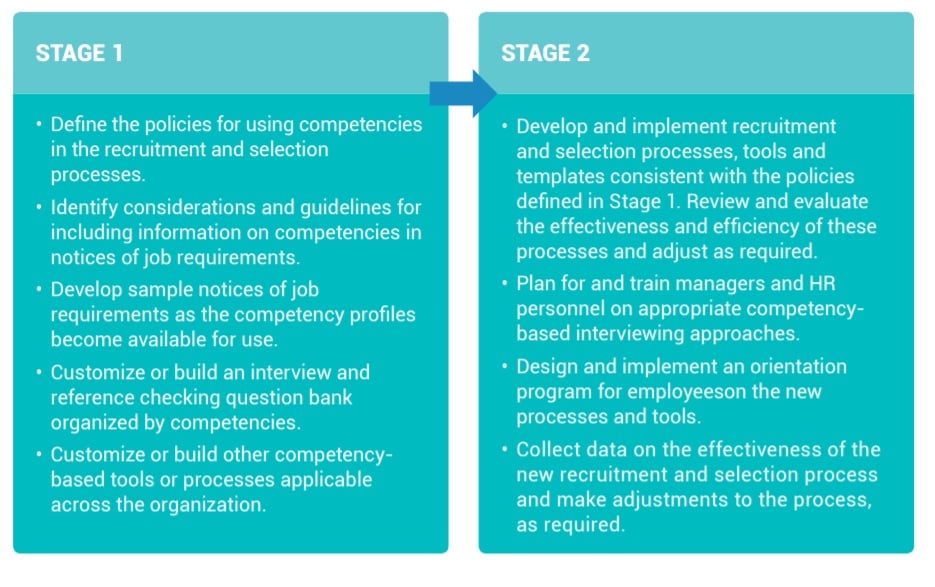
Stage 1
- Define the policies for using competencies in the recruitment and selection processes.
- Identify considerations and guidelines for including information on competencies in notices of job requirements.
- Develop sample notices of job requirements as the competency profiles become available for use.
- Customize or build an interview and reference checking question bank organized by competencies.
- Customize or build other competency-based tools or processes applicable across the organization.
Stage 2
- Develop and implement recruitment and selection processes, tools and templates consistent with the policies defined in Stage 1. Review and evaluate the effectiveness and efficiency of these processes and adjust as required.
- Plan for and train managers and HR personnel on appropriate competency-based interviewing approaches.
- Design and implement an orientation program for employees on the new processes and tools.
- Collect data on the effectiveness of the new recruitment and selection process and make adjustments to the process, as required.
Wait! Don't forget your competency sample pack!
Fill out the form below to access your Competency Sample Pack today!
Implementing Competencies for Learning & Development
Once your have defined the competency requirements, it becomes possible to develop learning strategies to address gaps in organizational competencies and to focus learning plans on the business goals and your organization’s strategic direction.
Best Practices for Implementing Competencies (Learning & Development)
Competency profiles assist in effective learning and development by identifying the behaviors, knowledge, skills and abilities that are necessary for successful performance in a job. Employees can assess their competencies against those required for their own job, or for another job in which they are interested, and then take steps to acquire or improve any necessary competencies.
Competencies support learning by:
- Focusing on the critical competencies needed for success in the job and organization,
- Providing standards for measuring employee performance and capabilities,
- Providing the framework for identifying learning options, curriculum, or programs to meet employee and organizational needs,
- Supporting effective forecasting of organizational or project-related learning requirements,
- Providing standards for determining how well learning has occurred, both at the individual and organizational level.
Common Tools and Practice for Implementing Competencies (Learning & Development)
Assessments Against Competencies
Once the competencies have been defined, it becomes possible to assess the employee’s competencies against those required for current or future roles within the organization. This assessment can occur in the following ways:
- Self-Assessment: Typically, the behavioral indicators for the competencies and proficiency levels needed within the target role are used as the standard for assessing the performance of the employee using a common rating scale. The results are compiled and a report is provided that includes the results for all competencies, highlighting both employee strengths and competencies requiring improvement. This information can then be used to support the development of an individual learning plan.
- Multi-source / 360: Multi-source or 360 degree feedback is similar to the self-assessment process except there is more than one assessor. The process includes at a minimum the employee and their supervisor, and can include others with whom the employee interacts within the workplace (for example: peers, team members, clients both within and outside the organization, reporting employees). A report is prepared on the feedback results to allow the employee, supervisor and others, such as a coach, mentor, or learning advisor, to target learning and development efforts to the particular needs of the employee.
- Assessment through other methods: Competency assessments can be accomplished through a wide variety of other methods, such as competency-based behavioral interviews, role-plays and simulations, and track record and portfolio reviews. As well, formalized assessment is often included as a component of employee development programs for the purpose of assessing the employee’s skills and competencies pre and post-learning.
Individual Learning Plans
Once employee strengths and areas for development have been defined, it becomes possible to develop individual learning plans targeted to particular learning needs.
At a minimum, tools to support this process include a set of instructions or guide for completing a learning plan as well as a standard learning plan form. Leverage automated solutions to improve the efficiencies of managing and tracking progress of individual learning plans.
Learning Resources Catalogued by Competency
Organizations often support employee learning by providing a catalogue of learning options organized by competencies, such as: on-the-job assignments and activities, books and written reference material, courses/workshops/conferences, videos, e-learning, etc.
Aggregate Reports on Organizational Gaps in Competencies
Individual gaps in competency requirements can be consolidated into group reports, and decisions can be made on the best strategies for closing the organizational gaps in the most fiscally prudent and cost-effective manner.
Program Design / Development
Having defined the competencies and behaviors required for success in a particular role, it becomes possible to target the design of curriculum and development programs to address these requirements. In addition, curriculum can be developed in a modularized fashion by competency, allowing the organization to quickly assemble a program of learning that will be specifically tailored to address organizational gaps.
Finally, many organizations establish comprehensive competency-based employee development programs in high need areas. These programs are staged development initiatives that include a formal assessment to evaluate progress and to accredit or certify that the employee has gained required competencies and knowledge.
In some cases, the employee is promoted to a higher level once certain performance standards have been met. This approach also demonstrates to employees that the organization is committed to their development and advancement within the organization.
Learning Evaluation / Validation
Competencies that have been identified for roles within the organization can serve as the standards or criteria for determining the level of success of learning interventions. This approach is particularly powerful because assessments based on the competencies provide the organization with an indication of the extent to which employee workplace behavior has improved.
For example, pre and post-learning event assessments can be conducted to evaluate the extent of development at both the individual and aggregate level. Based on this, the organization can determine whether the learning investments are paying off and, as appropriate, what changes need to be made to address performance gaps.
Implementation Stages
The following implementation stages are suggested for mid to large organizations implementing competencies in learning and development on a corporate-wide basis (see image below).
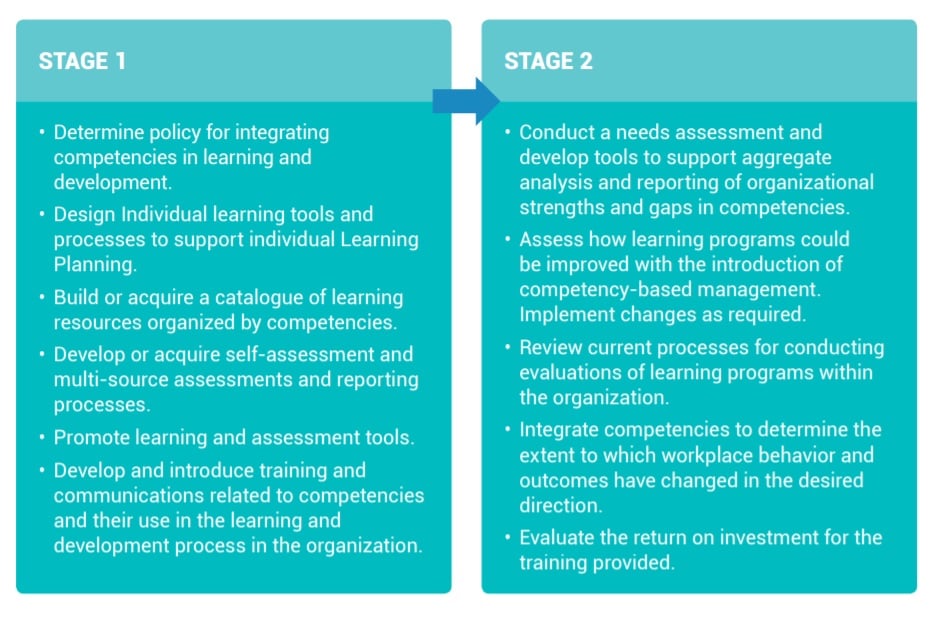
Stage 1
- Determine policy for integrating competencies in learning and development.
- Design Individual learning tools and processes to support individual Learning Planning.
- Build or acquire a catalogue of learning resources organized by competencies.
- Develop or acquire self-assessment and multi-source assessments and reporting processes.
- Promote learning and assessment tools.
- Develop and introduce training and communications related to competencies and their use in the learning and development process in the organization
Stage 2
- Conduct a needs assessment and develop tools to support aggregate analysis and reporting of organizational strengths and gaps in competencies.
- Assess how learning programs could be improved with the introduction of competency-based management. Implement changes as required.
- Review current processes for conducting evaluations of learning programs within the organization.
- Integrate competencies to determine the extent to which workplace behavior and outcomes have changed in the desired direction.
- Evaluate the return on investment for the training provided.
Implementing Competencies for Performance Management & Multi-Source Feedback
Performance management is about achieving results in a manner that is consistent with organizational expectations. Integrating competencies within the performance management process supports the provision of feedback to employees not only on “what” they have accomplished, but also “how” the work was performed.
Assessing competencies as a part of performance management is an important means of assisting employees in understanding performance expectations and enhancing competencies. Multi-source feedback is a method that is often used in performance management to assess and provide employees with feedback on “how” they preformed their work.
Best Practices for Implementing Competencies (Performance Management & Multi-Source Feedback)
Performance management programs are set up to provide feedback to employees on how effectively they are performing in their jobs. Such programs normally include a set of goals or objectives the employee must accomplish within the review period, as well as the standards or criteria for determining whether the defined goals have been accomplished.
Effective performance management include the following features:
- Linking individual goals to the corporate and work unit business plans and goals.
- Focusing on results, behaviors, and process improvement.
- Regular reviews and updating of performance plans to address changing demands.
- Training for both managers and employees on how to effectively give and receive feedback, including providing feedback to employees who experience challenges in performing to the standards required in their roles.
- Training for managers on how to provide performance evaluations that are valid, fair and unbiased.
Integrating Competencies in the Performance Management Process
Competencies can be integrated into the regular performance management process in two ways:
- By defining the competencies needed to perform each performance goal/objective: In this case, the manager and employee identify the key competencies required to achieve each performance goal/objective (typically 1 to 3 competencies per goal).
- At the end of the performance cycle, the employee’s performance is evaluated in relation to the goals as well as the key competencies associated with each goal. Using this approach, the competencies included in the employee’s performance plan may or may not completely coincide with the standard competency profile for the employee’s role.
- The advantage of using this method is that the competencies being assessed are entirely consistent with the employee’s performance goals for the performance review cycle. The disadvantage is that not all competencies within the competency profile for the employee’s role will necessarily be assessed within the cycle.
- By integrating the competencies for the employee’s job into the performance management process: In this case, the performance plan includes the performance goals/objectives for the review period, as well as the complete set of competencies from the competency profile for the employee’s role.
- The performance goals address “what” must be accomplished during the review period, and the competencies measure “how” the employee conducted him/herself to accomplish their work.
- The advantage of this method is that all competencies defined in the competency profile for the employee’s role are evaluated.
- The disadvantage is that due to the specific nature of the performance goals, key competencies required for effective performance during the review cycle that are not included in the competency profile will not be assessed.
In both cases, feedback provided on the employee’s competencies typically feeds into the development of a learning or action plan to address gaps in performance and development within or beyond the employee’s current role.
Multi-Source, 360 Degree and Upward Feedback
In multi-source, 360 degree and upward feedback, the behavioral indicators for the competencies needed within the target role are used as the standard for assessing the performance of the employee. In multi-source and 360 degree feedback, different stakeholder groups provide ratings, including the employee, their supervisor, as well as others with whom the employee interacts.
This can include peers, team members, clients both within and outside the organization, and reporting employees. In upward feedback, employees reporting directly or indirectly to the supervisor provide feedback on the supervisor’s performance.
The results are compiled and a report is provided to the employee. The report includes the results for all competencies, highlighting both the competencies that are strong, as well as those rated lowest by the different stakeholder groups. In almost all cases, individual ratings from others, excluding the employee’s supervisor, are combined in such a way as to protect the anonymity of the individuals providing the feedback.
The report is set up to show similarities and differences in ratings across the different stakeholder groups. The results of the process are normally used to develop learning and action plans for improvement. They can also feed into broader assessment programs to support employee career development or succession management within the organization.
Implementation Stages
The following implementation stages are suggested for mid to large organizations implementing competencies within performance management on a corporate-wide basis (see image below).
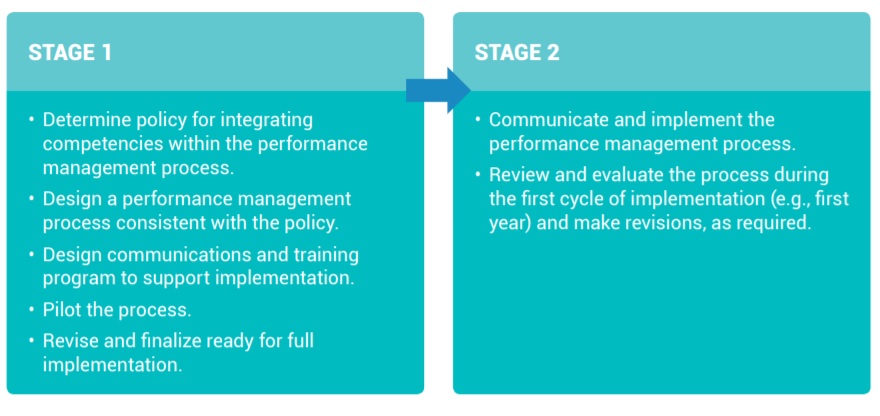
Stage 1
- Determine policy for integrating competencies within the performance management process.
- Design a performance management process consistent with the policy.
- Design communications and training program to support implementation.
- Pilot the process.
- Revise and finalize ready for full implementation.
Stage 2
- Communicate and implement the performance management process.
- Review and evaluate the process during the first cycle of implementation (e.g., first year) and make revisions, as required.
Implementing Competencies for Career Development & Succession Management
The populations of most western countries are aging, while most developing countries are experiencing accelerated demand for qualified workers who can meet the needs of their fast-growing economies.
Many organizations are experiencing difficultly keeping their organizations fully staffed with qualified resources, and organizations world-wide are realizing the importance of putting in place programs and initiatives to attract and retain well-qualified workers. These trends underscore the importance of career development and succession management initiatives aimed at preparing employees for increasing responsibilities within their organizations.
Best Practices for Implementing Competencies (Career Development & Succession Management)
Career development traditionally has been driven primarily by employees. Organizations provide the frameworks, tools and processes, but the responsibility rests with employees to take advantage of these to advance in their careers.
Succession Management, on the other hand, has traditionally been management driven. Critical roles are identified, and ranked lists of suitable candidates are prepared based on their existing competencies and potential to perform.
More recently, however, the lines between the traditional concepts of career development and succession planning have blurred. Organizations are instituting development programs that allow employees to progress through a phased program of development aimed at increasing employee competencies and preparing them to take on increased responsibility.
These programs typically include formalized in-class training, planned work assignments, assessments, and, “gradation” defined through some form of assessment, certification, or appointment to targeted roles or levels.
Basic Competency Architecture Requirements
Establishing effective career development and succession management programs starts at the planning stage by:
- Defining the competency architecture: Competency dictionaries and architectures are established to allow employees and managers to compare and contrast competency requirements across roles and levels within or across job groups.
- Defining career streams and roles: Beyond this, typical roles and career streams within the group to be profiled are defined. This allows both managers and employees to see how progression typically occurs. It also allows the organization to develop career development and succession management programs, tools and processes that support progression.
Common Tools and Practice for Implementing Competencies (Career Development & Succession Management)
Career development and succession management typically includes a selection of competency-based elements that address the requirements of the job group:
- Career stream information provided in a number of formats (for example, orientation programs and guidebooks),
- Employee guides to support self-directed development or participation in a planned program,
- Learning resource catalogues organized by competency,
- Training for both managers and employees on how the program works and how to gain the maximum benefit,
- Self-assessment or multi-source assessment to evaluate progress and development,
- Formal in-class training,
- E-learning elements,
- Work assignments or action learning exercises aimed at developing skill,
- Supervisory assessment of performance in roles or work assignments,
- A form or process that accredits or documents employee progress,
- Final assessment to validate that the employee has acquired the necessary competencies to be considered for targeted role.
Implementation Stages
The following implementation stages are suggested for mid to large organizations implementing competencies in support of career development and succession management (see image below).
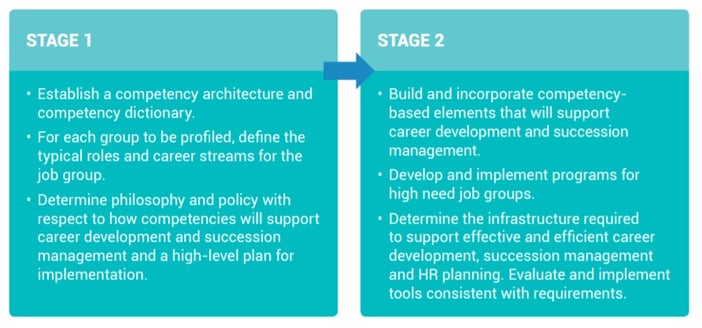
Stage 1
- Define the policies for using competencies in the recruitment and selection processes.
- Establish a competency architecture and competency dictionary.
- For each group to be profiled, define the typical roles and career streams for the job group.
- Determine philosophy and policy with respect to how competencies will support career development and succession management and a high-level plan for implementation
Stage 2
- Build and incorporate competency-based elements that will support career development and succession management.
- Develop and implement programs for high need job groups.
- Determine the infrastructure required to support effective and efficient career development, succession management and HR planning. Evaluate and implement tools consistent with requirements.
Implementing Competencies for Strategic Human Resources Planning
Human resources planning is a process that identifies current and future human resources needs for an organization to achieve its goals. Human resources planning should serve as a link between human resources management and the overall strategic plan of an organization.
Aging worker populations in most western countries and growing demands for qualified workers in developing economies have underscored the importance of effective human resources planning.
Best Practices for Implementing Competencies (Strategic Human Resources Planning)
The planning processes of most best practice organizations define not only what will be accomplished within a given timeframe, but also the numbers and types of people that will be needed to achieve the defined business goals (for example, number of people, the required competencies, when the resources will be needed).
Competency-based management supports the integration of human resources planning with business planning by allowing organizations to assess the current human resource capacity based on their competencies against the capacity needed to achieve the vision, mission and business goals of the organization. Targeted human resource strategies, plans and programs to address gaps are then designed, developed and implemented to close the gaps.
These strategies and programs are monitored and evaluated on a regular basis to ensure that they are moving the organizations in the desired direction and closing employee competency gaps.
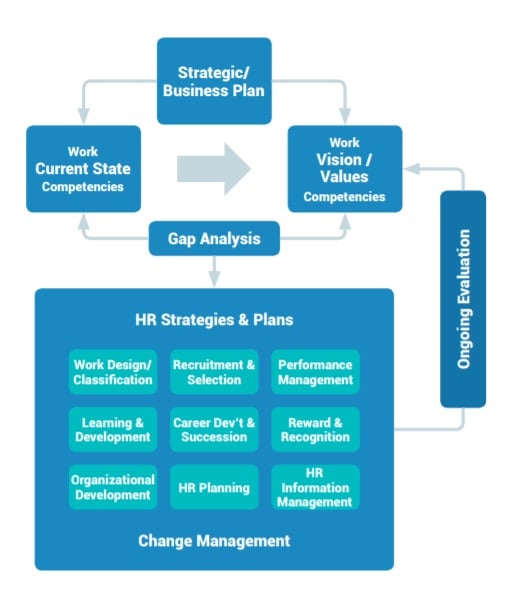
*Infographic of Strategic HR and Evaluation Cycle
Implementation Stages
The following implementation stages are suggested for mid to large organizations implementing competencies in support of strategic human resource planning (see image below).
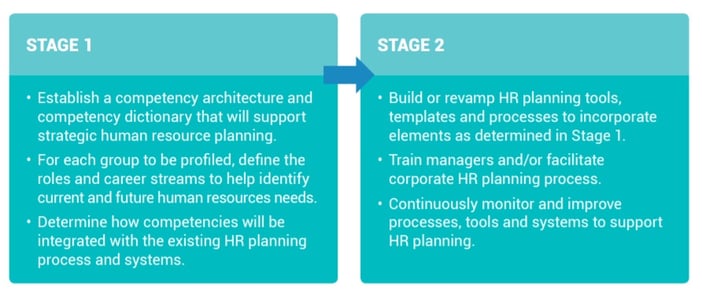
Stage 1
- Establish a competency architecture and competency dictionary that will support strategic human resource planning.
- For each group to be profiled, define the roles and career streams to help identify current and future human resources needs.
- Determine how competencies will be integrated with the existing HR planning process and systems
Stage 2
- Build or revamp HR planning tools, templates and processes to incorporate elements as determined in Stage 1.
- Train managers and/or facilitate corporate HR planning process.
- Continuously monitor and improve processes, tools and systems to support HR planning.
Overarching Policy, Process & Tools
Best Practices
Common Competency Dictionary and Architecture
Establishing a common competency dictionary and architecture is fundamental for the successful implementation of competencies throughout the organization. Maintaining this common architecture is essential for ensuring that all human resource management applications are fully integrated and that maximum efficiencies can be gained.
It is important, therefore, to identify an organizational group accountable for the maintenance of the competency dictionary and architecture on an ongoing basis.
Supporting Technology
In a recent review, the Gartner Group noted that competency-based talent management initiatives have not necessarily yielded the desired benefits and return on invest, for the main part because organizations have not invested in the infrastructure to facilitate full and effective implementation.
To gain maximum benefit from competency-based management, organizations need to have a technology solution that will support many of the implementation recommendations contained in this post.
Governance / Accountability Structure
Organizations that have effectively implemented competencies on a corporate-wide basis have ensured that there is an appropriate project management, governance and accountability framework in place to support the development, maintenance and revision / updating of the competency profiles to meet changing demands.
Implementation Stages
The following implementation stages are suggested for mid to large organizations.
Stage 1
- Establish a common competency dictionary and architecture to support competency profiling within the organization.
- Ensure that the internal and external project resources and framework are in place to support the development of competencies and their implementation in the planned applications.
- Review and establish the governance structure and accountabilities for implementing and maintaining competency-based management within the organization.
- Communicate the importance and the benefits of competency-based management for employees, managers and the organization regularly and widely.
- Identify the infrastructure and system requirements to support full implementation.
- Develop the competency profiles.
- Implement the competency profiles in a staged-way to demonstrate benefits and create buy-in.
- Communicate success stories as competency profiles are implemented.
Stage 2
- Develop, revise, update competency profiles to meet changing demands.
- Monitor and evaluate applications to ensure that they are meeting organizational needs, and adjust programs and plans as needed, to meet evolving needs.
How HRSG Can Help With Your Competency Implementation
Every successful competency initiative begins with the right competencies.
HRSG’s competencies are recognized worldwide for their unparalleled detail, accuracy, and usability. Each of our competencies is created by our team of industrial-organizational psychologists and subject-matter experts, and has been industry-validated to ensure it reflects the needs and best practices of today’s companies.
For over three decades, our Talent Management team has delivered products and best practice professional services in competency-based management, testing and assessment to define talent needs, address skill deficiencies and improve individual and organizational performance. In addition, we train HR professionals worldwide in our competency-based management methodologies.
Our 30+ years of expertise has also been distilled into a competency, job description and employee career management software solution called CompetencyCore. This solution leverages the power of AI, bringing together the power of competencies and the utility of job descriptions to help improve your HR processes.
It’s never been easier to customize, deploy, and manage competencies: Build a customized, multi-level competency framework affordably and in a fraction of the time with CompetencyCore, HRSG’s specialized competency management software.
CompetencyCore supports and automates the process of managing and using competencies within your organization. Minimize administrative effort and see results sooner with this streamlined, cloud-based solution.
Post last updated: October 2, 2020


Submit a Comment